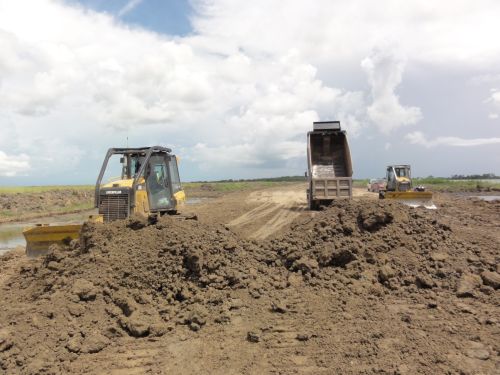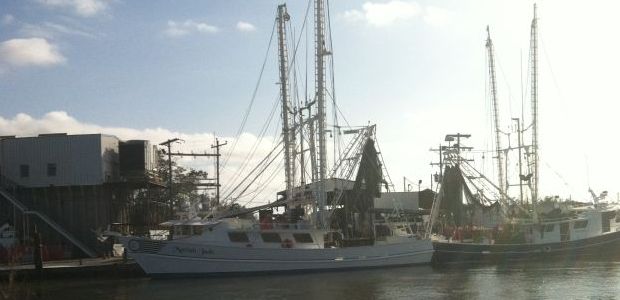
College’s best line up to assist Manning
July 16, 2013
FEMA reconsidering insurance maps
July 16, 2013When a hurricane heads for the Louisiana coast, most local shrimpers stay with their vessels, because tradition maintains it’s the safest place in a storm.
An increasing – though small – number of fishing families are including evacuating in their personal storm plans, however.
But Terrebonne Parish’s re-entry program may give them pause for thought.
Parish officials say shrimp boats are not considered essential for immediate recovery. So there are no provisions for fishermen who do leave to get back in and check their vessels early to ensure that pumps are still working or that tie lines remain secure.
“If you have a tidal surge you don’t know how the ropes hold up in a strong wind,” said veteran Houma shrimper James Blanchard, captain of the 63-foot steel hulled Waymaker. Docked in Chauvin, the vessel is brought up as far as possible by Blanchard when a named storm threatens. For the most part, he and his wife, Cheri, have remained at their Houma residence and so have no problem reaching the boat to check that all is well after a storm passes.
“When they shutdown re-entry for two weeks after a storm, it may cause my husband to reconsider leaving,” said Cheri Blanchard. “It’s unnerving wondering about the condition your vessel, equipment and property.
What the Blanchards and other fishing families want is the ability to come and check the boat as soon as possible if they do opt to evacuate. Parish officials say shrimp boats are not a priority, and that entry badges required for re-entry will not be provided to captains like Blanchard.
“It’s not that I’m unsympathetic,” said Terrebonne Parish President Michel Claudet. “Shrimp boats are not essential for us to get our economy up and running. We need to get the people to fix the infrastructure, to restore the services, to get them back in town.”
Claudet said he has discussed the issue of boats with emergency operations director Earl Eues, and that both have reached the same conclusion.
Terrebonne Parish, along with its economic development authority, has developed a three-tier system for parish re-entry.
The tiers are based on an agency or organization’s “contributions to the general infrastructure” of the parish.
Tier I is limited to agencies that need immediate access “to ensure restoration of critical services such as water, lighting and communications.”
The parish plan has room for a broader scope, however.
Tier II – the second group of people allowed back in – applies to relief workers, employees or officials of health care agencies, insurance agents, banking organizations and other “business operators considered critical to the recovery effort.”
Tier III entry is for owners or employees businesses outside the scope of Tier II as well as residents.
Lafourche Parish restricts entry to people needed for establishment of essential services, but after that entry is open to residents in general.
That doesn’t make Brad Friloux happy. A resident of St. Charles Parish, he keeps his 75-foot double-rigged Big Bad Brad docked in Dulac. If a storm results in a parish shut-down, he is concerned about having to wait days or weeks to check on its well-being.
“That’s pretty nice,” he said of the parish response to questions about shrimp boats, evincing bitterness. “I spend $150,000 or $200,000 per year in Terrebonne Parish. I ought to be able to check on my boat.”
The parish plan does include Tier II re-entry for what are described as “maritime operations” but that does not include commercial fishing vessel owners.
When told of the Terrebonne shutout of shrimp boat owners Clint Guidry, president of the Louisiana Shrimp Association, said he believes parish officials need to examine how they arrive at their priorities.
“I think the parish president needs to take a look at the dollars the shrimp industry brings to Terrebonne Parish,” Guidry said. “One of the lessons we learned from Hurricane Katrina is that you have to let your business people come back as soon as possible right after you do the rescue work. Are you going to allow processors and dock owners to come back in? If you do then you have to let fishermen come back in.”
Claudet was asked whether he and other officials had considered the unique nature of large vessels, from the standpoint of environmental threats from leaking fuel to damage that could be done to the property of others if lines are not secured.
But the answer remained the same.
Guidry said that making delineation – allowing large vessel owners to come in as opposed to smaller ones – does not serve a good purpose.
The parish’s “mosquito” fleet of small vessels is as necessary to economic recovery, in his opinion, as the larger ones.
The big boats can have values of $250,000 to $500,000 but James Blanchard – whose Waymaker falls into that category – agrees with Guidry.
“I don’t know that you should discriminate,” he said. “For the people with smaller boats, sometimes there is as much value or close to it as the big ones.”
Shrimp boats like these are among the vessels whose captains may not be able to re-enter Terrebonne Parish if they evacuate for hurricanes. Boat owners want to be able to tend vessels immediately after a storm to prevent drifting or sinking but parish rules make no allowance for that.










